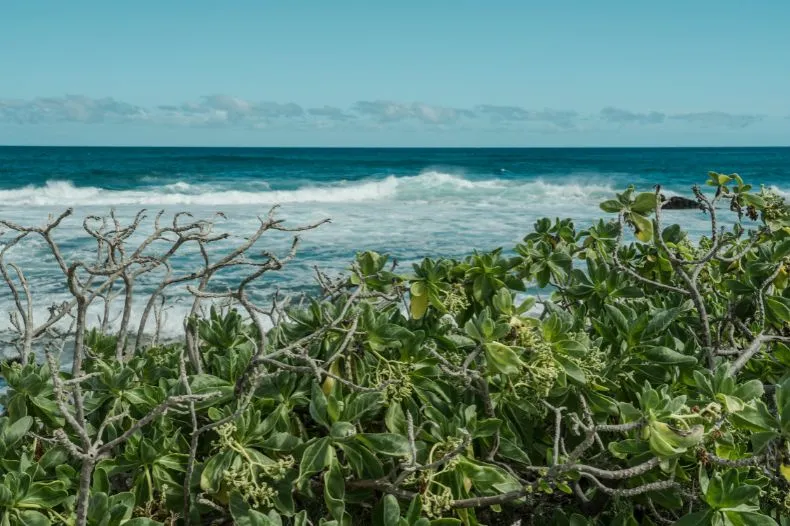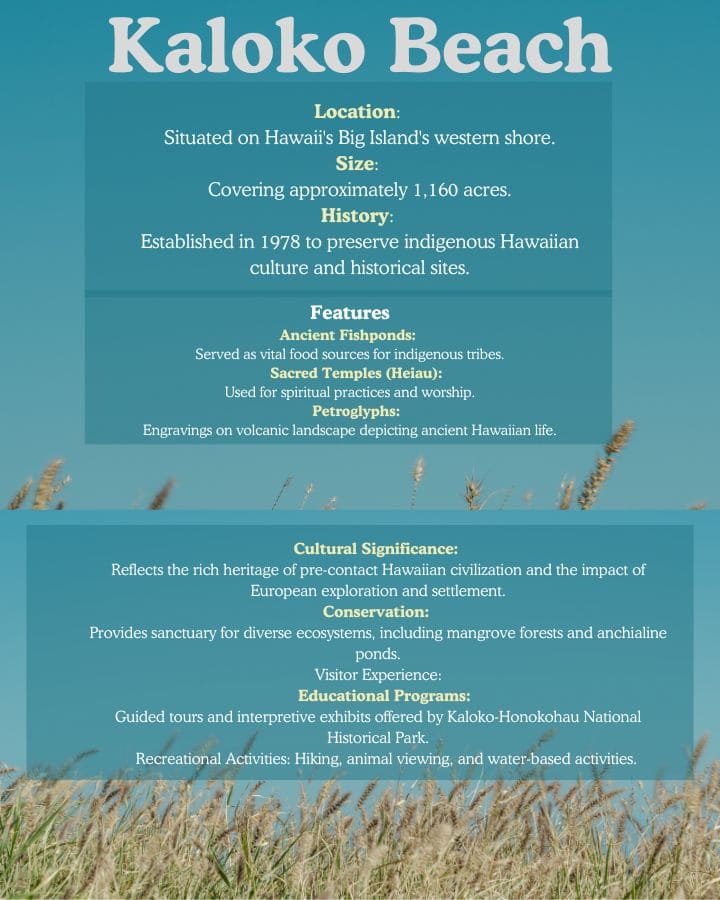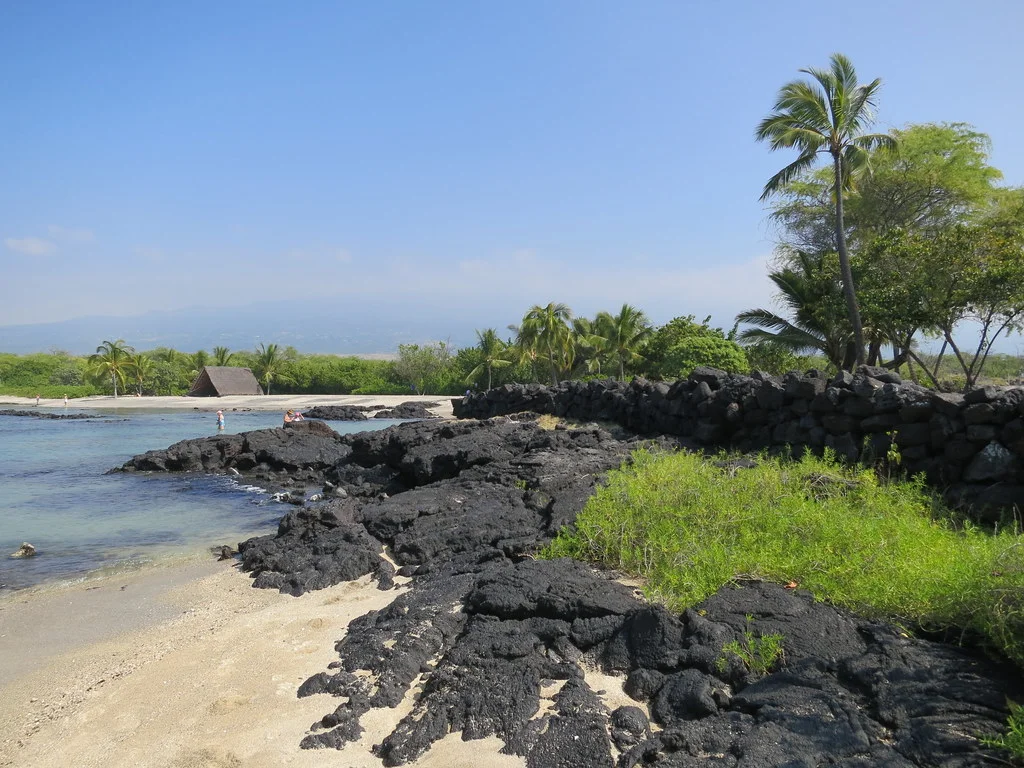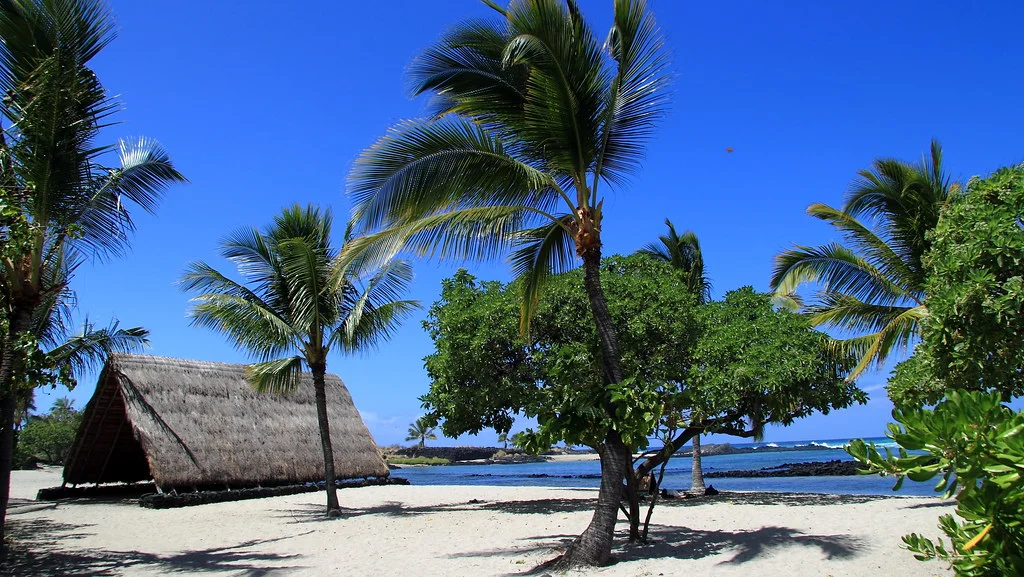
Situated on Hawaii‘s Big Island’s western shore, Kaloko Beach is a mesmerizing site that includes the historical and cultural riches of the Kaloko-Honokohau National Historical Park.
This picturesque seaside location invites guests to take a trip down memory lane and is a living example of the colorful fabric of Hawaiian heritage.
Discoverers are invited to discover Kaloko’s layers of cultural legacy, which range from ancient fishponds that provided sustenance for indigenous tribes to hallowed temples resounding with spiritual devotion.
Kaloko Beach is a 1,160-acre area that offers a mix of stunning natural settings and fascinating archaeological sites. Kaloko Beach’s sweeping Pacific Ocean waves transport tourists to a bygone era when Native Hawaiians coexisted peacefully with their surroundings.
The carefully built fishpond remnants made of lava rocks are quiet monuments to the inventiveness of a people who were closely entwined with the earth and the sea.
The story of Captain James Cook’s exploration in the late 18th century is woven with the park’s historical significance, which goes beyond its pre-contact origins.
The arrival of European influences paved the way for cultural transformations, which are captured at Kaloko-Honokohau National Historical Park.
Explore Kaloko Beach’s cultural treasures today, including the magnificent petroglyphs engraved into the volcanic landscape and the sacred Heiau of Haleo and Keeku.
The park’s natural beauty complements its historical appeal by acting as a haven for a variety of ecosystems in addition to protecting the palpable artifacts of a bygone period.
Entering Kaloko Beach is the beginning of an adventure that beyond the ordinary tourist encounter. It’s an immersion into Hawaii’s spirit, where the soft lap of the waves and the rustle of palm fronds carry the ghosts of the past.
With its picturesque scenery and rich cultural legacy, Kaloko welcomes guests to explore the essence of Hawaiian culture in the setting of an enduring coastal paradise.

History of Kaloko Beach
An old Hawaiian town with petroglyphs, temple platforms, and fishponds is preserved at Kaloko in Hawaii. The region displays both the effects of Western contact and indigenous Hawaiian culture.
It was created in order to save these important cultural locations back in 1978. The park provides information about the Native Hawaiians’ way of life as well as the changes brought about by European settlers.
Located on Hawaii’s Big Island’s western shore, Kaloko is a symbol of the rich cultural legacy and history of the Hawaiian people. Covering about 1,160 acres, this national park captures the spirit of prehistoric Hawaiian life with its elaborate fishponds, holy temples, and scenery that begs to be explored.
The history of Kaloko Beach is intertwined with the story of Hawaii as a whole, weaving together themes of European exploration, indigenous customs, and the meeting of two worlds.
Investigating this historical site’s past in depth is essential to understanding its value. Let’s start with the pre-contact era, when Native Hawaiians coexisted peacefully with their surroundings.
The Hawaiian people built a sophisticated and sustainable culture based on their ties to the land and sea long before European explorers arrived.
Kaloko-Honokohau’s historic fishponds, a marvel of traditional Hawaiian aquaculture, serve as a testament to this era. These elaborate structures, painstakingly constructed from lava rocks, provided a regulated environment for the cultivation of fish, thus supporting the island’s population.
The building of these fishponds demonstrated the Hawaiians’ inventiveness as well as their profound knowledge of the natural world.
A dependable source of food for the population was made possible by the interplay between the tides and the ingenious pond design, which allowed for the development of multiple fish species.
One is taken back in time to a time when sustainable practices were not just a choice but a way of life as they investigate the remains of these fishponds at Kaloko Beach.
The holy temples, or heiau, dotted over the park demonstrate the spiritual side of Hawaiian culture. The Hawaiians used these buildings as places of worship, using ceremonies and rituals to establish a connection between themselves and their gods and ancestors.
Within the park, the Heiau of Haleo and Keeku serve as silent reminders of the spiritual activities that once reverberated across the volcanic terrain.
The introduction of European settlers in the latter part of the 18th century was a turning point in the history of Hawaii and, by extension, Kaloko Beach.
Through his expedition of the Hawaiian Islands in 1778, Captain James Cook created the opportunity for more interaction with the outside world.
Cook’s early meetings with the Hawaiians were marked by mutual interest and exchanges, but as time went on, the island’s socio-political structure changed and foreign diseases were introduced.
The impact of Western culture on traditional Hawaiian ways of living increased with time. The once-thriving population had to contend with illnesses like smallpox and social upheavals brought on by the arrival of new ideas and technologies.
This time of transition is captured in Kaloko-Honokohau National Historical Park, which provides an insight into the intricate interactions between native customs and outside influences.
Due to the park’s coastline position, which attracted Western settlers, its importance increased as the Hawaiian Kingdom dealt with the effects of outside influence.
During this period, the ahupua’a system, a traditional land division structure, experienced changes that affected resource management and land ownership.
These socio-cultural changes are attested to by the remains of the Kaloko fishponds and the archeological sites located inside the park.
The introduction of missionaries and the development of sugar plantations in the 19th century brought about more changes.
The development of Honokohau Harbor in the early 20th century significantly changed the coastal environment, and the park’s landscape became entwined with the era’s economic endeavors.
Once the site of traditional Hawaiian customs, Kaloko Beach has changed to reflect the shifting trends in business and industry.
In 1978, Kaloko-Honokohau National Historical Park was established, which was a significant step in preserving Hawaii’s cultural legacy.
The National Park Service set out on a mission to preserve and interpret the region’s historical, cultural, and natural treasures after realizing the significance of the location.
Today, guests to the park can stroll around the ruins of revered temples, investigate the historic fishponds, and learn about the colorful past of Kaloko Beach.
Apart from its significance in history and culture, Kaloko Beach provides a sanctuary for a variety of ecosystems. Because of the park’s coastal setting and close proximity to the ocean, a variety of plants and animals can find a special home.
The area’s ecological diversity is enhanced by mangrove forests, anchialine pools, and coastal vegetation, which provide a striking contrast to the park’s historical sites.
The park’s initiatives to involve visitors in the preservation of this natural and cultural asset demonstrate its dedication to conservation and education.
The goal of outreach programs, guided tours, and interpretive programs is to help people appreciate the fine balance that must be struck between protecting the environment and cultural heritage.
By taking these steps, Kaloko-Honokohau National Historical Park hopes to preserve this Hawaiian treasure’s value for upcoming generations.
Importance of kaloko Beach as a Tourist Destination

Due to its distinctive fusion of historical, cultural, and natural aspects, Kaloko Beach is a popular tourist destination that offers guests a varied experience.
Cultural Heritage:
Within the Kaloko-Honokohau National Historical Park, Kaloko Beach provides a glimpse into Hawaii’s rich cultural past.
By exploring historic fishponds, revered temples, and petroglyphs, visitors can learn more about the customs and way of life of the Native Hawaiians. The park connects visitors with Hawaii’s heritage by acting as an outdoor museum.
Historical Significance:
The historical significance of the park, particularly its connection to Captain Cook’s arrival and the ensuing changes brought about by European contact, enhances the overall experience for visitors. Visitors can see the physical remnants of a bygone age, which helps them comprehend Hawaii’s complicated past.
Natural Beauty:
Kaloko Beach is a beautiful beach that is encircled by a variety of ecosystems, such as mangrove forests and anchialine ponds. Nature lovers are drawn to the area by its scenic splendor and close proximity to the water, which offer opportunities for activities such as bird watching and coastline exploring.
Educational Opportunities:
Visitors can learn more about the history and significance of the location with the help of the educational programs and guided tours offered by Kaloko-Honokohau National Historical Park.
Visitors who are interested in learning about Hawaiian culture and history will find it to be an engaging experience thanks to interpretive exhibits and ranger-led activities that increase the educational value.
Recreational Activities:
Numerous recreational opportunities are available in the park, including hiking paths, animal viewing, and water-based pursuits. Enjoying the outdoors while immersed in the natural environment makes Kaloko Beach a desirable travel destination for individuals looking for a combination of adventure and cultural discovery.
Conservation Awareness:
An appealing feature for travelers who care about the environment is the park’s dedication to conservation and environmental management. In order to foster a sense of responsibility for sustainable tourism practices, visitors can learn about the initiatives to protect natural and cultural resources.
Cultural Events and Festivals:
Hawaiian customs may be celebrated at festivals and cultural events held at Kaloko Beach, offering visitors an engaging and participatory experience.
These gatherings frequently feature traditional crafts, music, and dancing, which livens up the experience for guests.
Gateway to Exploration
Situated on the Big Island’s western shore, Kaloko Beach serves as an ideal starting point for discovering other neighboring sites.
Travelers have easy access to additional beautiful locations, beaches, and natural wonders, which makes it possible for them to explore the area more thoroughly.
Tips for visitors visiting Kaloko Beach

Here are some crucial pointers to improve your visit to Kaloko Beach:
Educate Yourself: Learn about the park’s cultural and historical significance before you visit. You’ll appreciate the historic fishponds, temples, and petroglyphs much more if you know the background.
Guided Tours: You might want to take advantage of the park rangers’ guided tours. Your entire stay will be enhanced by these tours, which provide insightful information about the ecological value, cultural practices, and history of the park.
Respect Cultural Sites: Be mindful of the holiness of cultural locations. Do not handle petroglyphs, and do not move any items. Respect the posted rules in order to maintain the park’s historical integrity.
Keep on approved Paths: on preserve the park’s fragile ecosystems, stay on approved trails and paths. This guarantees both visitor and site safety and contributes to the preservation of the natural environment.
Bring Necessities: Don’t forget to pack water, sunscreen, and cozy walking shoes. For a comfortable visit, it’s important to stay hydrated and use sun protection due to the hot tropical heat.
Observations on animals: Look for a variety of animals when exploring, such as local birds and sea life. To reduce disruption, keep a polite distance and observe silently.
Photography Etiquette: Use your camera to record special moments, but remember to follow the rules. To guarantee that every visitor has a great experience, keep in mind your surroundings and refrain from utilizing flash near delicate artifacts.
Check Visitor Center: Arrive at the park’s visitor center to begin your adventure. Maps, details on ongoing activities, and updates on park laws can all be found here. The competent staff can provide insightful advice based on your hobbies.
Cultural Events: See if there are any festivals or cultural events scheduled for the time you will be there. These gatherings offer a fantastic chance to interact with Hawaiian customs, music, and dance, enhancing your understanding of the culture.
Leave No Trace: Dispose of all of your waste according to the “Leave No Trace” guidelines. Leave the park’s natural and cultural elements alone so that future generations can appreciate them.
By following these suggestions, you’ll not only make the most of your time at Kaloko Beach but also help to protect the area’s distinctive natural and cultural legacy.
Conclusion
In conclusion, Kaloko stands as a living testament to the intricate tapestry of Hawaiian history. From the ancient fishponds that sustained indigenous communities to the sacred temples that echoed with spiritual reverence, the park encapsulates the essence of a bygone era.
As visitors walk along the shores of Kaloko Beach, they not only witness the remnants of a vibrant past but also become part of a collective effort to preserve and celebrate the cultural and ecological richness of this remarkable national historical park.
